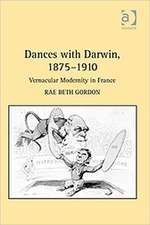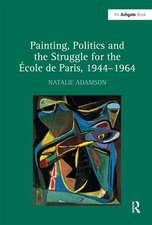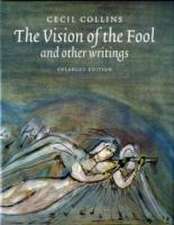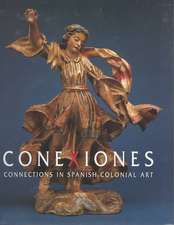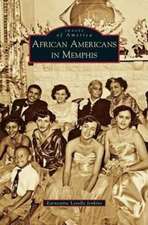Race, Representation & Photography in 19th-Century Memphis: From Slavery to Jim Crow
Autor Earnestine Lovelle Jenkinsen Limba Engleză Hardback – 6 ian 2016
| Toate formatele și edițiile | Preț | Express |
|---|---|---|
| Paperback (1) | 392.60 lei 6-8 săpt. | |
| Taylor & Francis – 30 sep 2020 | 392.60 lei 6-8 săpt. | |
| Hardback (1) | 855.40 lei 6-8 săpt. | |
| Taylor & Francis – 6 ian 2016 | 855.40 lei 6-8 săpt. |
Preț: 855.40 lei
Preț vechi: 1220.32 lei
-30% Nou
Puncte Express: 1283
Preț estimativ în valută:
163.68€ • 170.89$ • 135.47£
163.68€ • 170.89$ • 135.47£
Carte tipărită la comandă
Livrare economică 04-18 aprilie
Preluare comenzi: 021 569.72.76
Specificații
ISBN-13: 9781409468196
ISBN-10: 1409468194
Pagini: 320
Dimensiuni: 174 x 246 x 18 mm
Greutate: 0.88 kg
Ediția:1
Editura: Taylor & Francis
Colecția Routledge
Locul publicării:Oxford, United Kingdom
ISBN-10: 1409468194
Pagini: 320
Dimensiuni: 174 x 246 x 18 mm
Greutate: 0.88 kg
Ediția:1
Editura: Taylor & Francis
Colecția Routledge
Locul publicării:Oxford, United Kingdom
Notă biografică
Earnestine Lovelle Jenkins is Associate Professor of Art History, Department of Art, University of Memphis, USA.
Recenzii
'Jenkins’s text presents a meticulously researched account of Memphis in the nineteenth century and draws our attention to many previously overlooked threads in its local history, including urban slavery, contraband camps, charitable networks, church communities, entrepreneurship, and women’s work in and outside the home. While the book covers an enormous number of themes, her strict focus on a single city during one century makes the text cohesive and manageable.'
--CAA Reviews
'Race, Representation & Photography in 19th-Century Memphis is an exemplary tour de force consisting of breathtaking scholarship and compelling and exceptional research, as well as brilliant archival excavation and investigation.'
--Celeste-Marie Bernier, Nottingham University, UK
'Earnestine Jenkins's extraordinarily rich and unique visual study of nineteenth-century Memphis makes an invaluable contribution to the history of African Americans in slavery and freedom. Race, Representation & Photography in 19th-Century Memphis is richly textured and illuminates the multi-layered efforts of black people to create new representations of themselves, their families and institutions, and enables us to better comprehend their strivings. She brilliantly and persuasively argues that the material culture and documents produced by an array of black community photographers laid the foundation for what would become the "New Negro" movement in the early twentieth century. We are indebted to Jenkins for the prodigious research, insightful and persuasive analysis, and the amazing diversity of images that make Race, Representation & Photography in 19th-Century Memphis so uniquely important and a must-read.'
--Darlene Clark Hine, Northwestern University, USA and co-editor of The Black Chicago Renaissance
--CAA Reviews
'Race, Representation & Photography in 19th-Century Memphis is an exemplary tour de force consisting of breathtaking scholarship and compelling and exceptional research, as well as brilliant archival excavation and investigation.'
--Celeste-Marie Bernier, Nottingham University, UK
'Earnestine Jenkins's extraordinarily rich and unique visual study of nineteenth-century Memphis makes an invaluable contribution to the history of African Americans in slavery and freedom. Race, Representation & Photography in 19th-Century Memphis is richly textured and illuminates the multi-layered efforts of black people to create new representations of themselves, their families and institutions, and enables us to better comprehend their strivings. She brilliantly and persuasively argues that the material culture and documents produced by an array of black community photographers laid the foundation for what would become the "New Negro" movement in the early twentieth century. We are indebted to Jenkins for the prodigious research, insightful and persuasive analysis, and the amazing diversity of images that make Race, Representation & Photography in 19th-Century Memphis so uniquely important and a must-read.'
--Darlene Clark Hine, Northwestern University, USA and co-editor of The Black Chicago Renaissance
Descriere
Using Victorian era photographs, engravings, and pictorial illustrations from local and national archives, this unique study examines intersections of race and image within the context of early African American communities. It emphasizes black agency, looking at how African Americans in Memphis manipulated the power of photography in the creation of free identities. Blacks are at the center of a study that brings to light how wide-ranging practices of photography were linked to racialized experiences in the American south following the Civil War.



